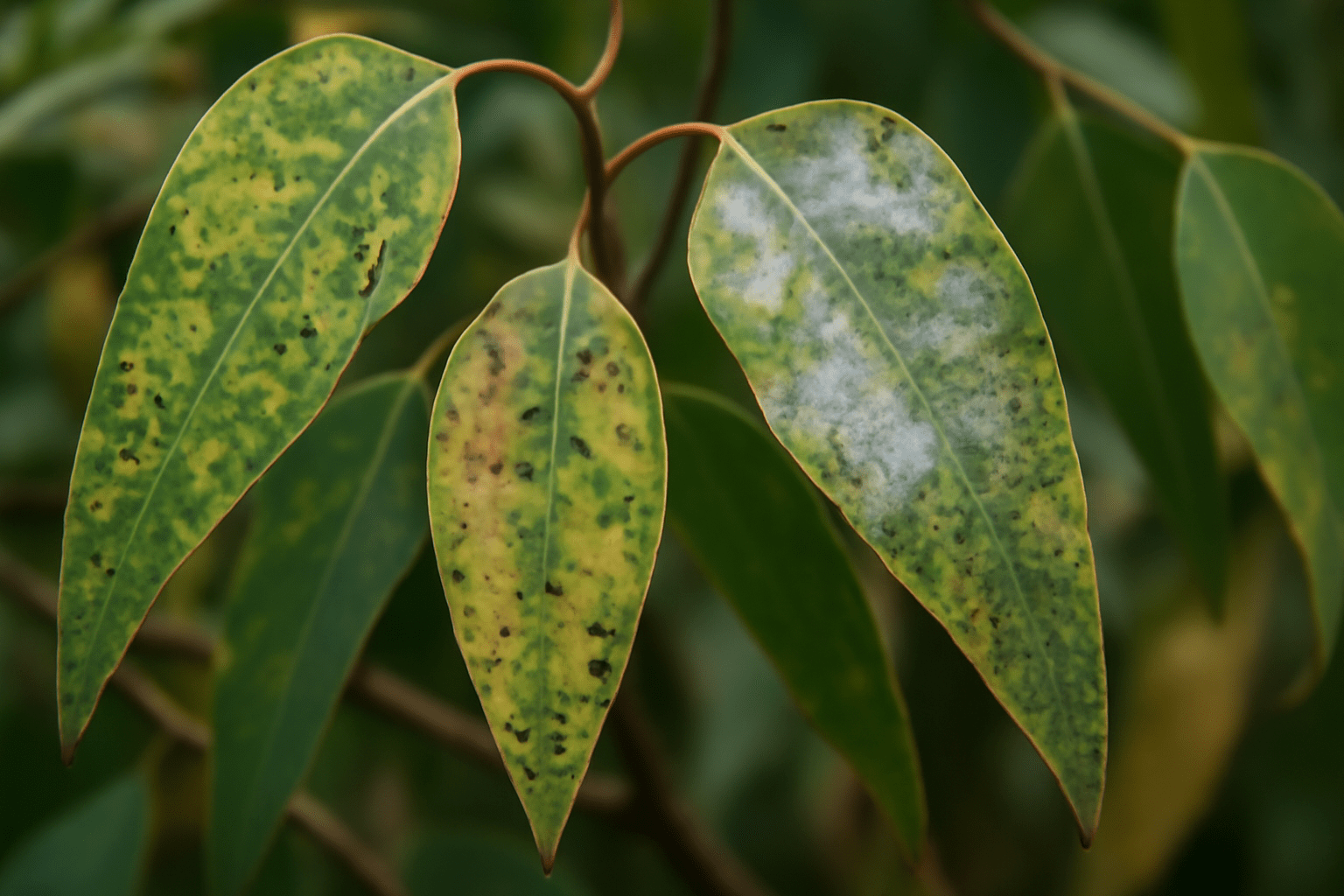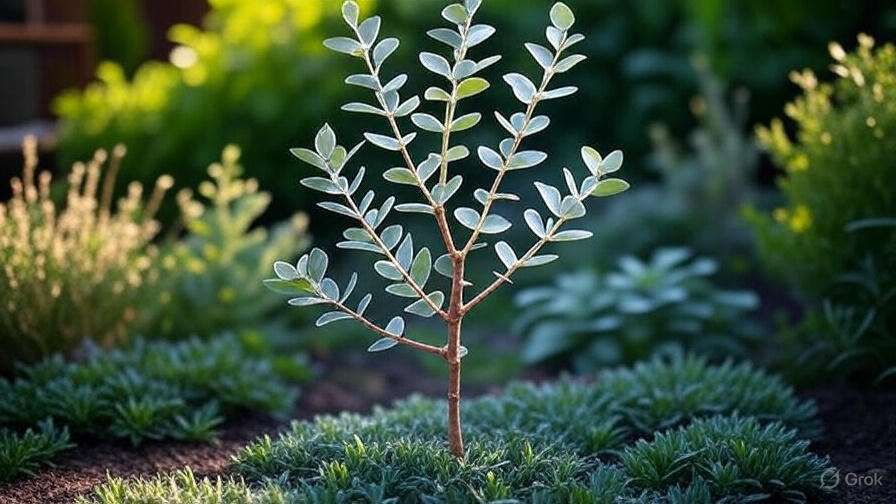
Choosing and Caring for a Small Eucalyptus Tree: Expert Tips for Success
Looking for a stunning tree that doesn’t take up too much space? 
However, growing and caring for a small eucalyptus tree can be tricky for beginners. Without the right knowledge, you might struggle with its care needs, watering, or even selecting the right variety. Don’t worry – in this expert guide, we’ll walk you through everything you need to know about choosing the right small eucalyptus tree, planting it properly, and ensuring it thrives in your garden or home. Let’s dive in and make sure your eucalyptus tree flourishes!
Table of Contents
Toggle Understanding the Small Eucalyptus Tree
Understanding the Small Eucalyptus Tree
If you’re considering adding a small eucalyptus tree to your garden or landscape, you’re making a smart choice! These compact versions of the iconic eucalyptus are not only visually stunning but also surprisingly easy to care for—perfect for beginners and busy homeowners alike 
 What Is a Small Eucalyptus Tree?
What Is a Small Eucalyptus Tree?
A small eucalyptus tree is a dwarf or compact variety of the eucalyptus species. Unlike their tall forest cousins, these trees stay manageable in size—usually under 15 feet—making them ideal for small yards, patios, or even large pots. Popular varieties include:
- Eucalyptus gunnii ‘Azura’ – Cold-hardy and fast-growing
- Eucalyptus pauciflora ‘Little Snowman’ – Great for ornamental use
- Eucalyptus gregsoniana – Naturally compact and perfect for pots
These trees still offer that fresh, aromatic scent eucalyptus is known for, along with silvery blue-green foliage that adds charm year-round 
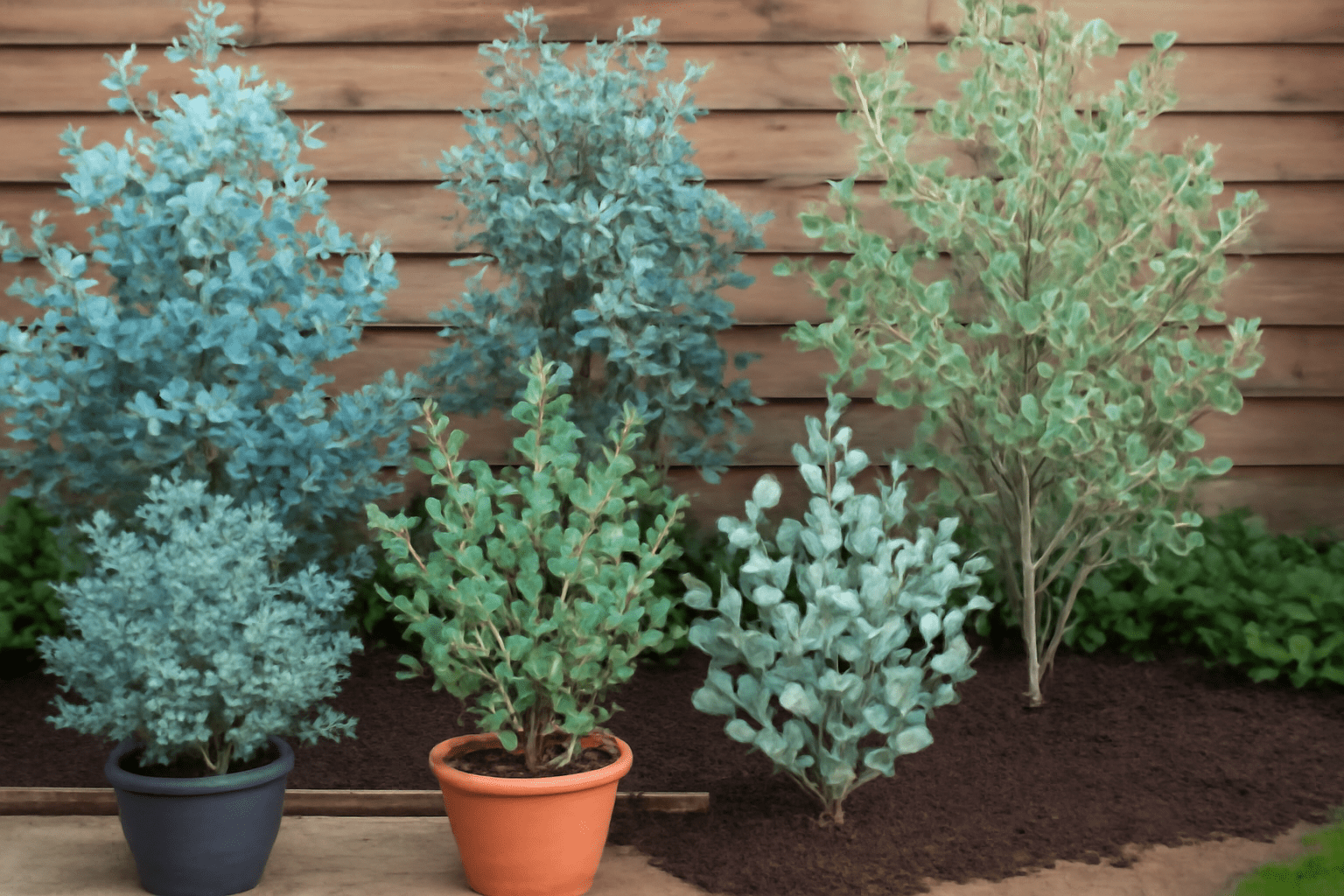
 Why Choose a Small Eucalyptus Tree?
Why Choose a Small Eucalyptus Tree?
Small eucalyptus trees are loved for more than just their looks. Here’s why they’re a smart addition to your outdoor space:
Low Maintenance – Minimal pruning, drought-tolerant, and pest-resistant
Fast Growing – You’ll see results in just a few seasons
Multi-Purpose – Use them for privacy, fragrance, cut branches, or pollinator attraction
Space-Saving – Perfect for small gardens, courtyards, or balcony containers
 Where Do They Grow Best?
Where Do They Grow Best?
Small eucalyptus trees love full sun and well-draining soil. While they’re native to Australia, many dwarf varieties have been bred to thrive in a range of climates—from mild coastal zones to colder areas (some tolerate frost down to -10°C/14°F!).

 Quick Care Snapshot
Quick Care Snapshot
- Watering: Keep soil lightly moist while young. Once established, water during dry spells.
- Soil: Light, well-drained, and slightly acidic
- Fertilizer: Not usually needed—these trees grow just fine with basic soil nutrition
- Pruning: Light annual pruning keeps them tidy and encourages bushier growth
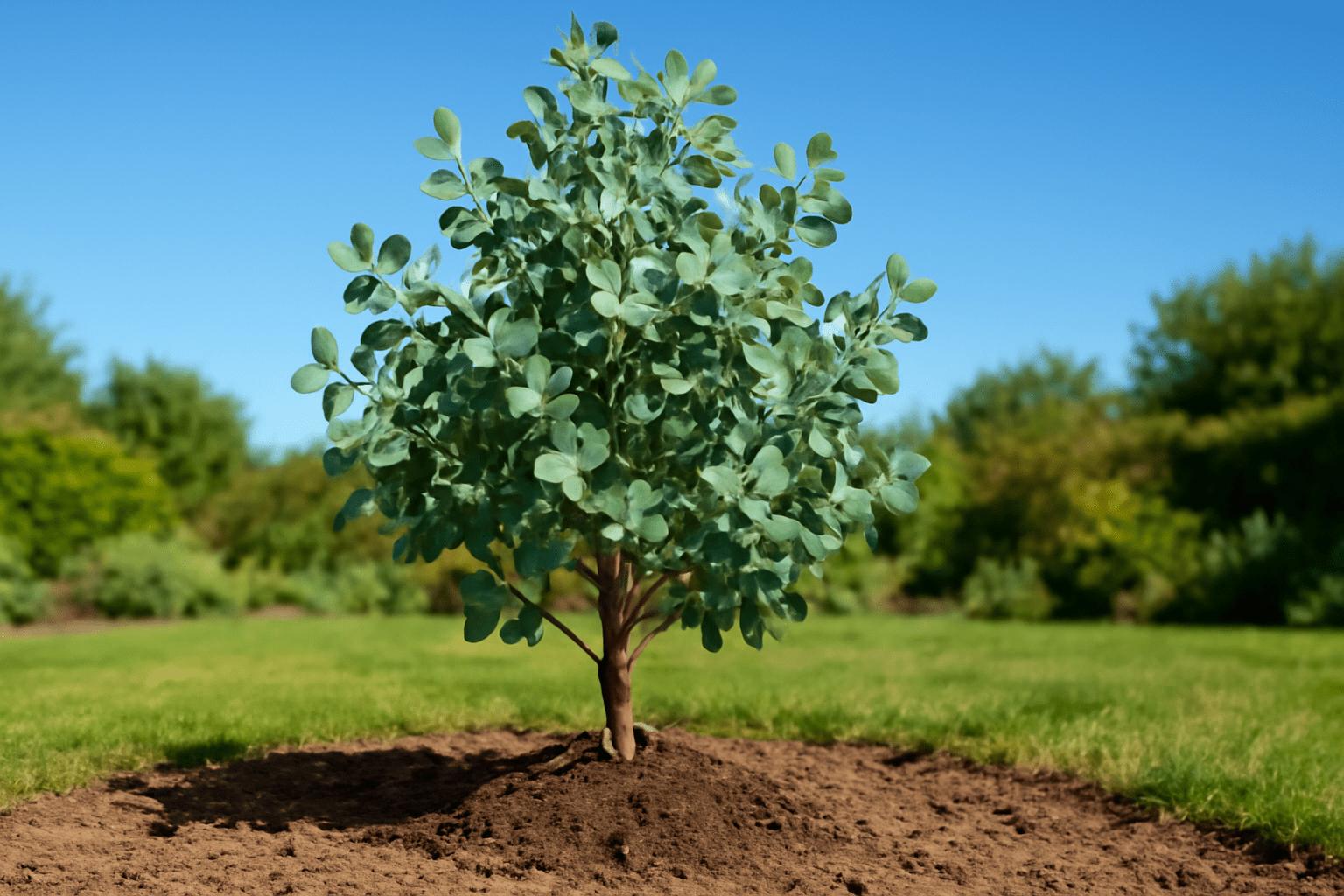
 Choosing the Right Small Eucalyptus Tree for Your Space
Choosing the Right Small Eucalyptus Tree for Your Space
Not all eucalyptus trees are towering giants—many compact varieties are perfect for small gardens, patios, or even pots! Choosing the right type of small eucalyptus tree can make all the difference in how well it thrives and enhances your outdoor space. Let’s break down how to pick the perfect one for your needs
 Know Your Space First
Know Your Space First
Before diving into specific types, take a good look at where you want to plant your tree:
- Full Sun or Partial Shade? Eucalyptus loves sunlight, so choose a sunny spot if possible.
- Ground or Container? Some varieties are better suited for pots, while others need space to stretch their roots.
- Climate Check
: Make sure the species is compatible with your local weather—some are frost-tolerant, while others aren’t.
 Best Small Eucalyptus Varieties to Consider
Best Small Eucalyptus Varieties to Consider
Here are a few beginner-friendly, space-conscious choices:
- Eucalyptus gunnii ‘Azura’
A compact, cold-hardy variety with beautiful silver-blue leaves. Great for pots or small garden beds. Grows up to 10–15 ft (3–4.5 m) but can be pruned to size. - Eucalyptus parvula (Small-Leaved Gum)
Known for its delicate leaves and bushy habit. Tolerates cooler climates and responds well to pruning. Ideal for informal hedging. - Eucalyptus crenulata (Buxton Gum)
This rare and elegant species stays smaller and has ornamental, crinkled foliage. Perfect for adding texture and a soft scent to patios. - Eucalyptus pulverulenta ‘Baby Blue’
Loved by florists! This small tree produces silvery-blue foliage that’s perfect for cutting. Usually kept under 8 ft (2.5 m) with regular pruning.
 Pro Tip: Size Control with Pruning
Pro Tip: Size Control with Pruning
Even fast-growing eucalyptus can be kept compact with regular pruning. Don’t be afraid to shape your tree—most species respond well and will reward you with thicker, bushier growth.
 Quick Decision Guide
Quick Decision Guide
Space Type | Best Choice | Key Benefit |
Small Yard | E. gunnii ‘Azura’ | Cold-hardy, manageable height |
Patio Container | E. pulverulenta ‘Baby Blue’ | Compact, fragrant, ornamental |
Mild Climates | E. parvula or E. crenulata | Textured leaves, aesthetic form |
Privacy Screen | E. parvula (with pruning) | Dense, leafy growth |
 Final Tip
Final Tip
When in doubt, start small and grow smart. A young eucalyptus tree adapts more easily to pruning and container life. Pick a variety that fits your lifestyle—not just your space—and you’ll have a stunning, low-maintenance addition to your garden for years to come
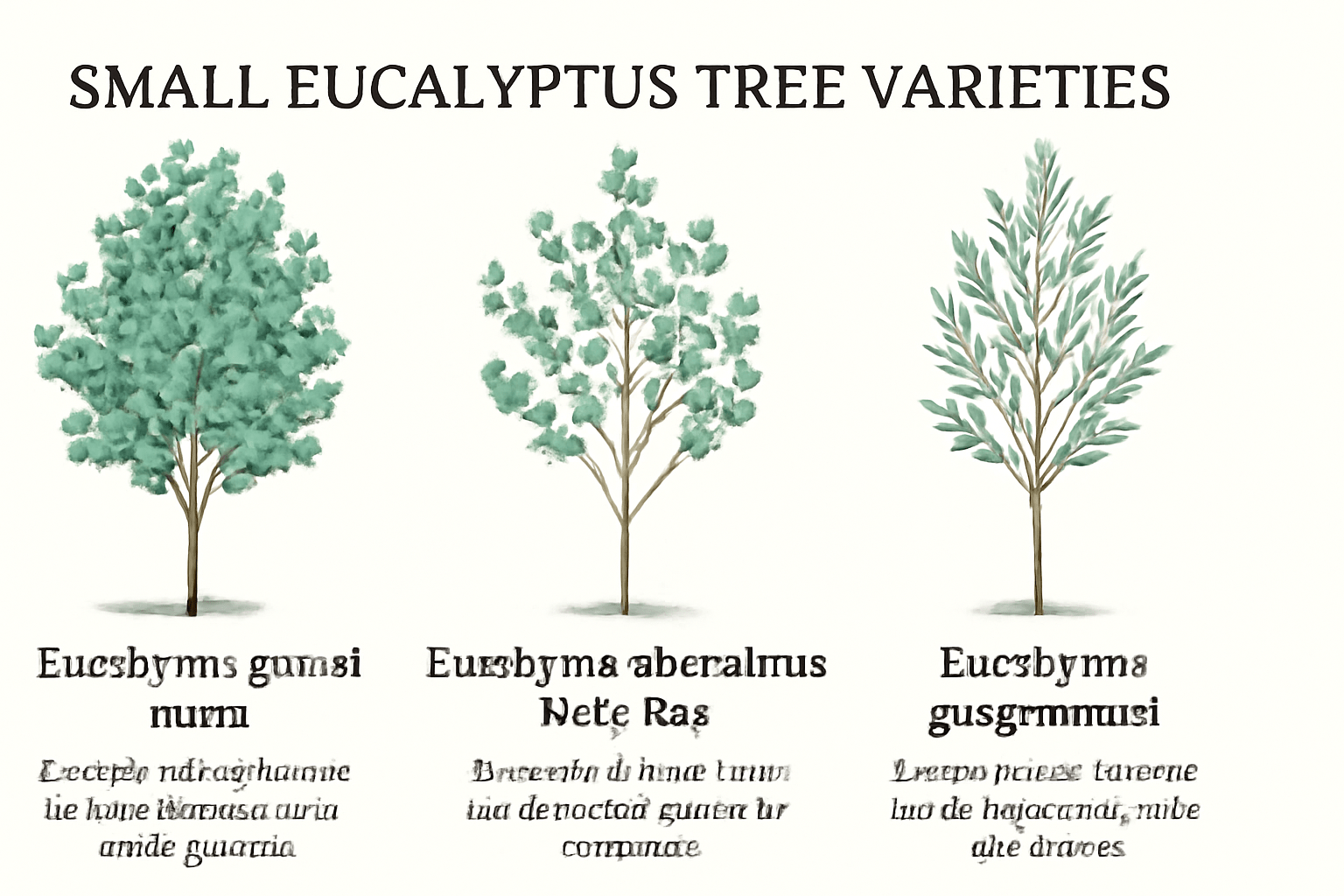
 Preparing to Plant Your Small Eucalyptus Tree
Preparing to Plant Your Small Eucalyptus Tree
Getting ready to plant your small eucalyptus tree is one of the most important steps to ensure it thrives for years to come. Whether you’re adding it to your backyard, a container garden, or a landscape project, proper planning sets the stage for healthy growth and less maintenance later on. Here’s how to do it right—step by step.
1. Pick the Perfect Spot 
Eucalyptus trees love sunshine! Choose a location that gets at least 6 hours of direct sunlight each day. These trees are sun worshippers and won’t do well in shady or damp areas.
Also, give your tree room to grow—avoid planting too close to buildings, fences, or underground pipes. Even small varieties need space for their roots and branches.
2. Check Your Soil 
Eucalyptus prefers well-draining soil. Heavy clay or waterlogged soil can lead to root rot. Test your soil by digging a small hole and filling it with water—if it drains within an hour, you’re good to go.
If needed, improve your soil by mixing in compost or sand to boost drainage and add nutrients.
3. Plan for Drainage & Wind Protection 
If you live in an area with strong winds, choose a sheltered location or install a temporary windbreak. Young eucalyptus trees can be top-heavy and may need support until they establish a stronger root system.
Good drainage is non-negotiable—consider planting on a mound if your yard tends to stay soggy.
4. Container or Ground? Choose Wisely 

- In a pot: Use a large container (at least 18–24 inches wide) with drainage holes. Choose dwarf or compact eucalyptus varieties for container growth.
- In the ground: Perfect for those in warm climates (USDA zones 8–11). Once in the soil, eucalyptus grows fast and typically doesn’t like being moved.
Bonus Tip: If you’re unsure about your climate, try planting in a container first and moving it indoors during colder months.
5. Prep Your Planting Tools & Materials 
Before planting day, gather:
- Gardening gloves
- A shovel or spade
- Mulch (to retain moisture and block weeds)
- A watering can or hose
- Organic compost or slow-release fertilizer (optional but helpful)
Being prepared means less stress—and fewer trips back to the shed!
6. Water Before You Plant 
Give your eucalyptus seedling a deep drink of water an hour before planting. This helps reduce transplant shock and keeps the root ball moist while you prepare the hole.
By following these simple yet crucial steps, you’re laying the groundwork (literally!) for a happy, healthy eucalyptus tree. Up next: how to plant it properly and give it the best care from day one 







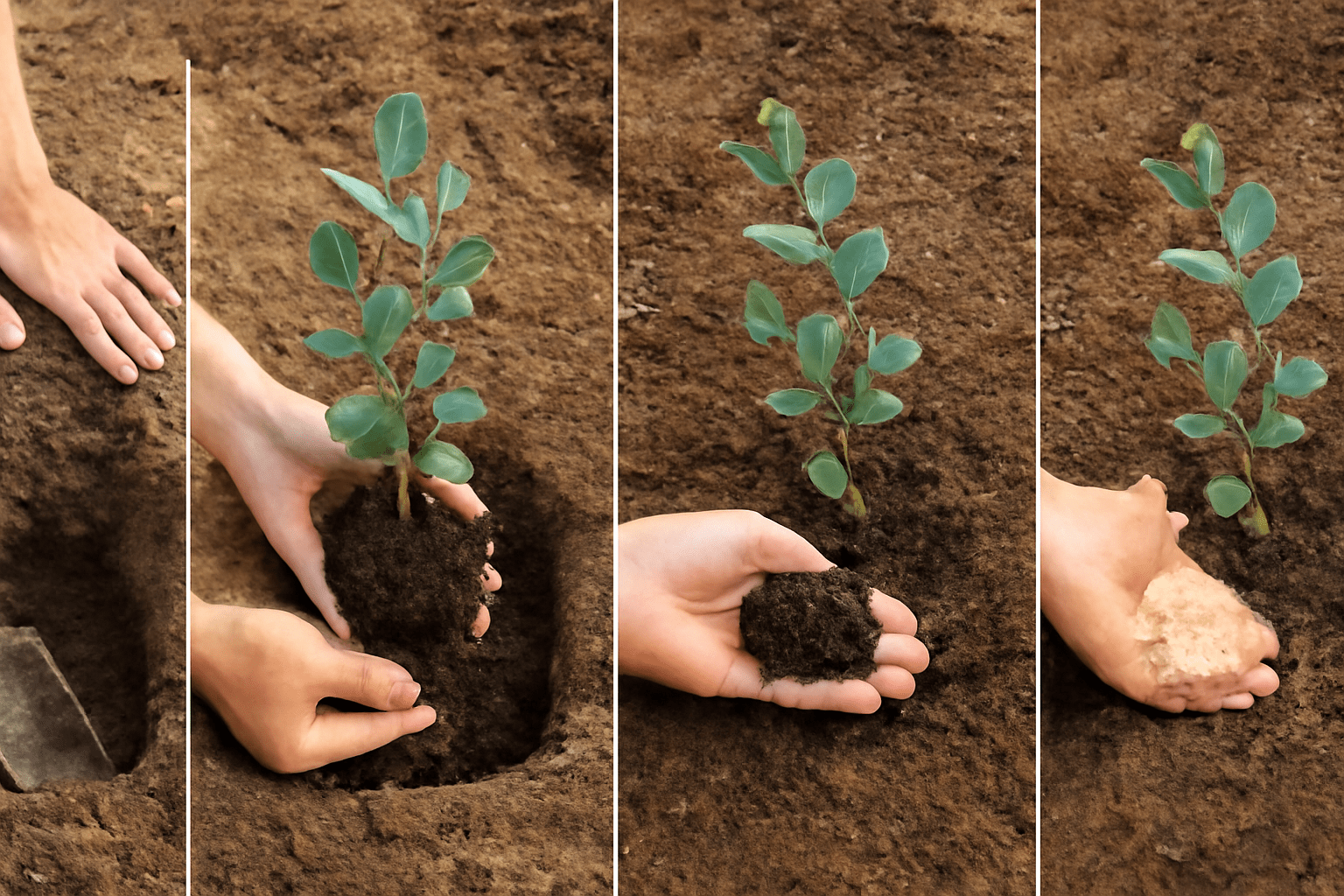
 Watering and Feeding Your Small Eucalyptus Tree
Watering and Feeding Your Small Eucalyptus Tree
Caring for a small eucalyptus tree starts with getting the basics right—especially watering and feeding. Whether it’s growing in a pot or in your garden, this hardy yet fast-growing tree needs a little attention to stay healthy and vibrant. Let’s break it down
 How to Water Your Eucalyptus Tree
How to Water Your Eucalyptus Tree
Consistency is key, but eucalyptus trees hate soggy roots. Follow these simple tips:
- Newly planted trees need regular watering—about 2–3 times a week—for the first few months. This helps them establish strong roots.
- Once established, water once a week during dry periods. Eucalyptus trees are drought-tolerant but still need occasional deep watering.
- Check the soil before watering. If the top 2 inches feel dry, it’s time to water.
- For potted eucalyptus, make sure your pot has good drainage to prevent root rot
.

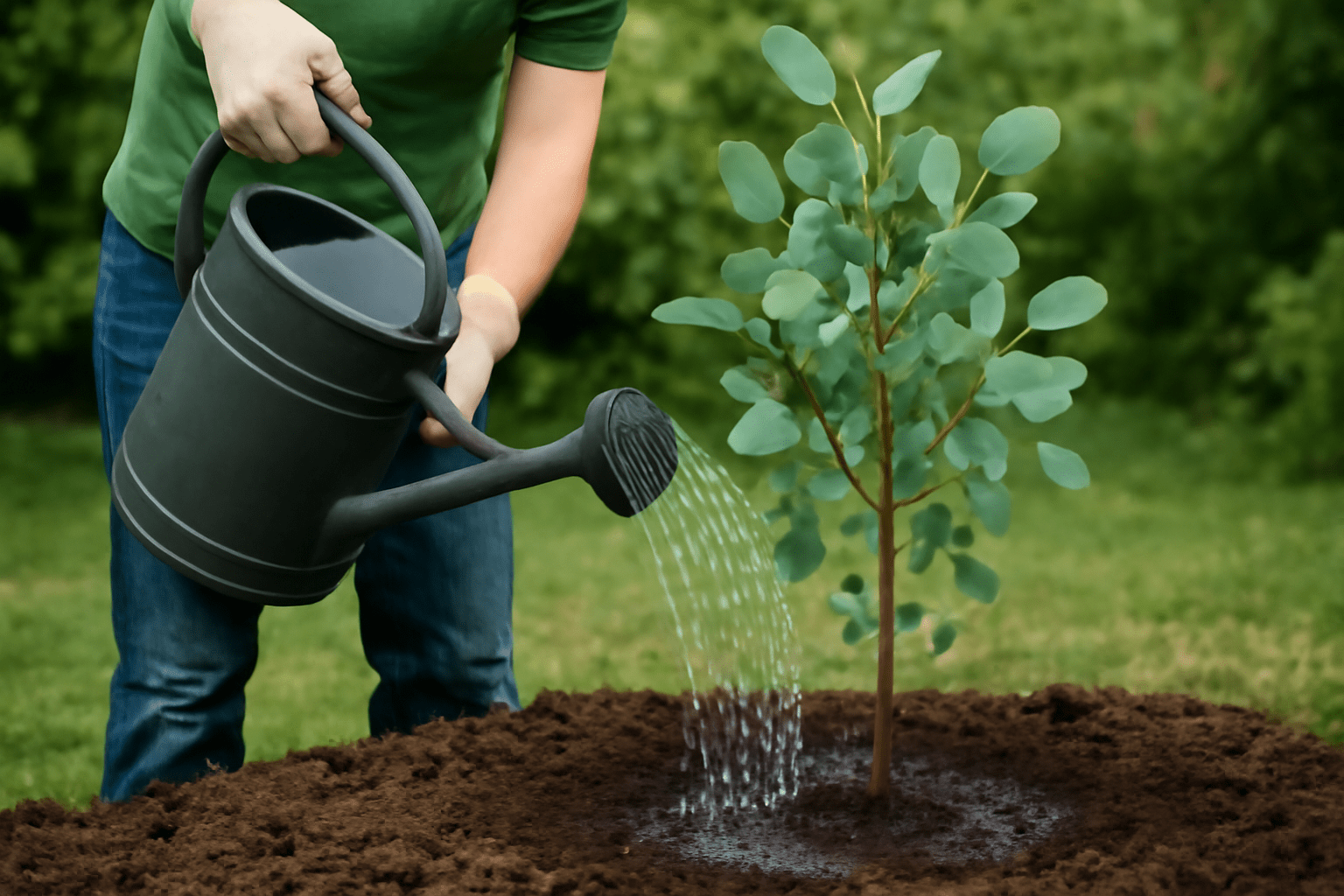
 Best Fertilizer for Eucalyptus Trees
Best Fertilizer for Eucalyptus Trees
Eucalyptus trees don’t need heavy feeding, but the right nutrients can give them a healthy boost 
- Use a balanced, slow-release fertilizer in early spring (like 10-10-10 or 12-6-6).
- Fertilize once or twice a year—spring and midsummer are ideal.
- Avoid overfeeding. Too much fertilizer can lead to leggy growth and weak branches.
If you prefer organic options, compost or a diluted liquid seaweed feed works wonders.
 Watering & Feeding Schedule (Quick Guide)
Watering & Feeding Schedule (Quick Guide)
Season | Watering Frequency | Feeding Tip |
Spring | 2x/week (young trees) | Add slow-release fertilizer |
Summer | 1x/week (deep soak) | Optional second light feed |
Fall | As needed (watch rainfall) | No fertilizing needed |
Winter | Minimal (only if dry) | Do not feed during dormancy |
 Watch for These Signs
Watch for These Signs
- Yellowing leaves? May be overwatering or poor drainage.
- Slow growth? Tree might need a nutrient boost.
- Leaf drop in summer? Normal, especially in dry heat—but increase watering slightly.
 Final Tips
Final Tips
- Stick to a routine—your tree will thrive with consistent care.
- Always prioritize drainage—especially in pots.
- Less is more. Eucalyptus trees are low-maintenance and don’t need pampering
.
By mastering watering and feeding, you’ll help your small eucalyptus tree grow strong, healthy, and beautiful for years to come!
Pruning and Shaping Your Small Eucalyptus Tree 

Pruning and shaping your small eucalyptus tree isn’t just about keeping it tidy—it’s key to maintaining its health, size, and stunning appearance. Whether you’re growing it in a pot or directly in your garden, the right approach to pruning ensures your eucalyptus stays compact, bushy, and beautiful year-round. Let’s break it down into simple steps so you can prune with confidence.
 Why Prune Your Eucalyptus?
Why Prune Your Eucalyptus?
Eucalyptus trees grow fast—even the dwarf varieties! Without regular pruning, they can become leggy, sparse, or too tall for your space. Pruning:
- Encourages fuller, bushier growth
- Controls height and width for small gardens or containers
- Prevents weak branches and improves air circulation
- Boosts overall plant health and longevity
 When to Prune
When to Prune
The best time to prune is late winter to early spring, just before new growth starts. Avoid heavy pruning in fall, as it may stress the plant before winter.
Light shaping can be done throughout the growing season to manage size or remove awkward growth.
 How to Prune Like a Pro
How to Prune Like a Pro
- Use sharp, clean tools – A good pair of pruning shears or loppers will make cleaner cuts and prevent disease.
- Remove dead or damaged branches first – This improves plant health immediately.
- Cut above a leaf node or bud – Always prune just above where new growth can emerge.
- Shape for balance – Step back often and prune to maintain a rounded, even canopy.
- Thin out crowded branches – This helps light and air reach the center of the tree
.
 Shaping Tips for Small Spaces
Shaping Tips for Small Spaces
Want that lush, ornamental look? Try these strategies:
- Coppicing: Cut the tree back to near ground level once a year to encourage dense, shrubby regrowth. Great for foliage harvest or compact form.
- Standard Tree Style: Trim lower branches gradually and shape the canopy for a classic mini-tree look.
- Espalier (advanced): Train your eucalyptus flat against a wall or fence—ideal for tight spots or decorative designs.
 Common Mistakes to Avoid
Common Mistakes to Avoid



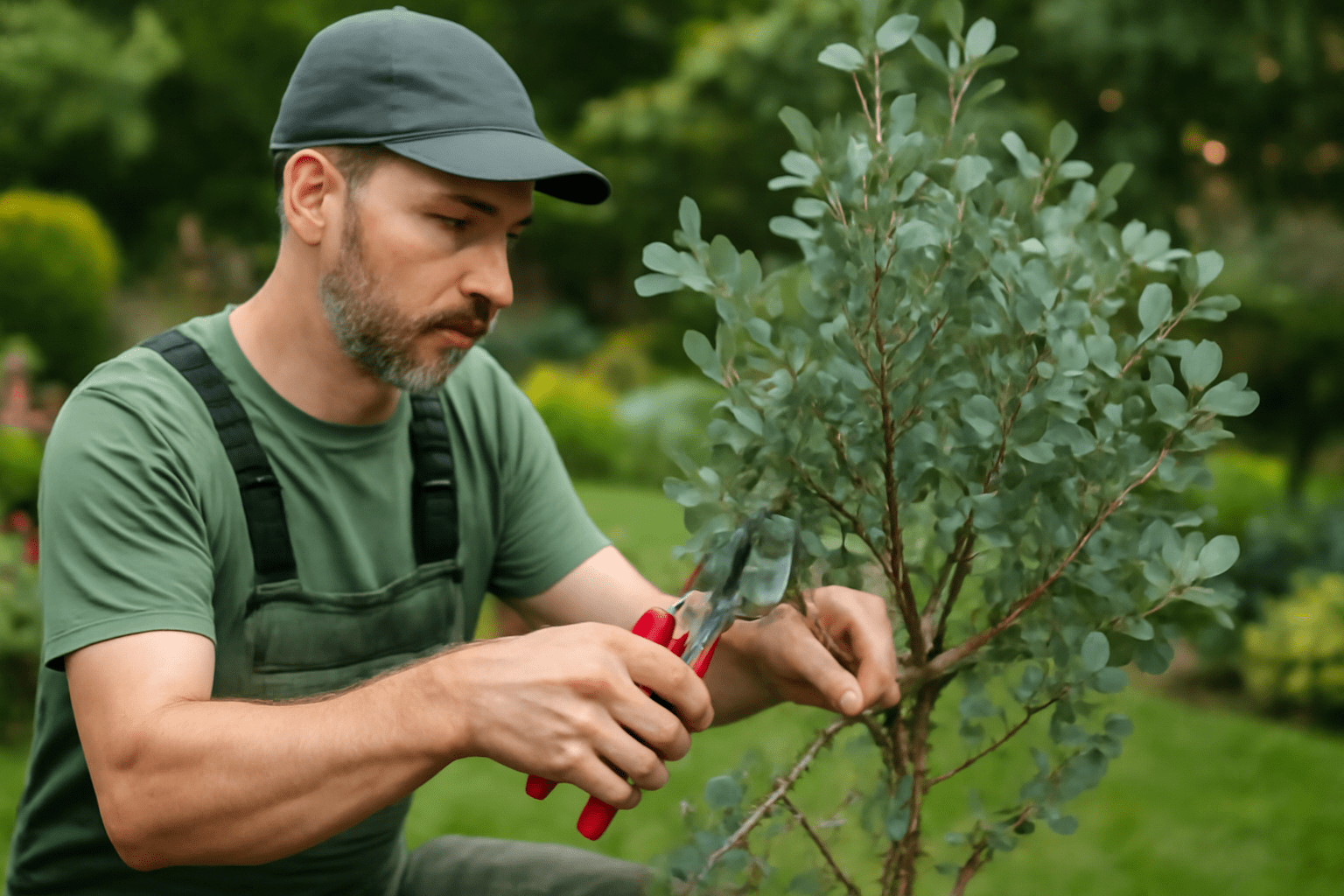
 Common Problems and Troubleshooting for Small Eucalyptus Trees
Common Problems and Troubleshooting for Small Eucalyptus Trees
Even with the best care, small eucalyptus trees can run into issues. The good news? Most problems are easy to spot and fix—if you know what to look for. Here’s a quick guide to the most common challenges and how to tackle them with confidence.
1. Leaf Curling or Drooping 
What it means:
Your eucalyptus may be thirsty—or stressed.
Likely causes:
- Underwatering (especially during hot spells)
- Sudden transplant shock
- Overly dry or compacted soil
Quick fix:
Water deeply but less frequently. Ensure the soil drains well. Add mulch to retain moisture and reduce heat stress.
2. Yellowing Leaves 
What it means:
Something is off with water or nutrients.
Likely causes:
- Overwatering or poor drainage
- Nutrient deficiency (especially nitrogen)
- Root rot from soggy conditions
Quick fix:
Let the soil dry slightly between waterings. Use a balanced, slow-release fertilizer in spring. Improve drainage if water pools around the base.
3. Pests Like Psyllids or Aphids 
What it means:
Tiny bugs are feasting on your tree.
Signs to watch for:
- Sticky residue (honeydew)
- Leaf discoloration or spotting
- Visible insects under leaves
Quick fix:
Spray with neem oil or insecticidal soap weekly until pests are gone. Encourage ladybugs or lacewings—they love eating aphids!
4. Powdery Mildew or Leaf Spots 
What it means:
Fungal disease is setting in, often due to poor airflow or excess humidity.
Likely causes:
- Crowded planting
- Wet leaves from overhead watering
- Lack of sun
Quick fix:
Trim surrounding plants to improve airflow. Always water at the base. Remove and discard infected leaves. Apply a mild organic fungicide if needed.
5. Stunted Growth or Sparse Foliage 
What it means:
Your eucalyptus may be stressed or root-bound.
Likely causes:
- Container too small (for potted trees)
- Poor soil quality
- Lack of sunlight
Quick fix:
Repot if roots are circling inside the container. Use nutrient-rich, well-draining soil. Move the tree to a full-sun spot (6–8 hours daily).
6. Cold Damage (Especially in Winter) 
What it means:
Eucalyptus isn’t happy with frost or freezing temps.
Common signs:
- Blackened or crispy leaves
- Drooping branches
- Bark splitting
Quick fix:
Protect young trees with frost cloth or burlap. Water before a freeze to insulate roots. In colder regions, grow eucalyptus in pots so you can move them indoors.
 Quick Troubleshooting Checklist
Quick Troubleshooting Checklist
Problem | Possible Cause | Solution |
Droopy leaves | Underwatering | Water deeply and mulch |
Yellowing leaves | Overwatering | Improve drainage |
Sticky leaves | Pests | Use neem oil |
White powder | Fungal disease | Improve airflow, apply fungicide |
Slow growth | Poor soil or light | Replant or reposition |
Frost damage | Cold snap | Cover or move plant |
Long-Term Care and Maintenance of Your Small Eucalyptus Tree
Keeping your small eucalyptus tree healthy and thriving for years requires consistent care, smart planning, and a bit of seasonal attention 
 1. Stick to a Routine Watering Schedule
1. Stick to a Routine Watering Schedule
Once established, eucalyptus trees are drought-tolerant—but young or container-grown trees need regular watering.
- First 1–2 years: Water deeply once a week.
- Mature trees: Water during extended dry spells only.
Always check the top few inches of soil—if dry, it’s time to water.
 2. Maximize Sunlight Exposure
2. Maximize Sunlight Exposure
Eucalyptus trees love full sun! Make sure your tree gets at least 6 hours of direct sunlight daily.
For potted trees, rotate the container every few weeks so all sides get even sun exposure.
 3. Feed Annually for Healthy Growth
3. Feed Annually for Healthy Growth
Apply a balanced, slow-release fertilizer in early spring to boost foliage and root health. Choose a fertilizer high in nitrogen for lush green leaves 
Tip: Over-fertilizing can cause weak growth—once a year is enough for most small eucalyptus types.
 4. Prune for Shape and Safety
4. Prune for Shape and Safety
Annual pruning helps maintain your tree’s compact size and shape.
- Prune in late winter or early spring, before new growth starts.
- Remove dead, damaged, or crossing branches.
- For bushier growth, lightly trim the tips of young branches
.
Don’t be afraid to cut back—eucalyptus responds well to pruning!
 5. Repot Container Trees Every 2–3 Years
5. Repot Container Trees Every 2–3 Years
If your eucalyptus is in a pot, it will outgrow its container. Repot into a larger pot with fresh soil every few years to avoid root binding.
Signs it’s time to repot:
- Roots poking out of the drainage holes
- Soil dries out quickly
- Tree looks stressed or stunted
 6. Protect from Cold and Wind
6. Protect from Cold and Wind
Many eucalyptus varieties are frost-sensitive. If you’re in a cooler climate:
- Move container trees indoors or into a greenhouse during freezing temps
- Mulch the base of in-ground trees to protect roots
- Use windbreaks for exposed areas—eucalyptus leaves can scorch in strong winds
 7. Watch for Pests and Diseases
7. Watch for Pests and Diseases
Eucalyptus trees are generally hardy, but keep an eye out for:
- Psyllids (lerp insects)
- Aphids
- Fungal leaf spots
Use insecticidal soap or neem oil if infestations occur, and ensure good air circulation to prevent disease.
 Final Tip: Observe and Adapt
Final Tip: Observe and Adapt
Every tree is unique! Regularly check in with your eucalyptus—look at the leaves, soil, and overall vigor. The more in tune you are with your tree, the easier it is to catch issues early and keep it thriving for years to come
By following these long-term care practices, your small eucalyptus tree can remain a stunning, fragrant, and low-maintenance focal point in your garden or patio space for many seasons ahead.
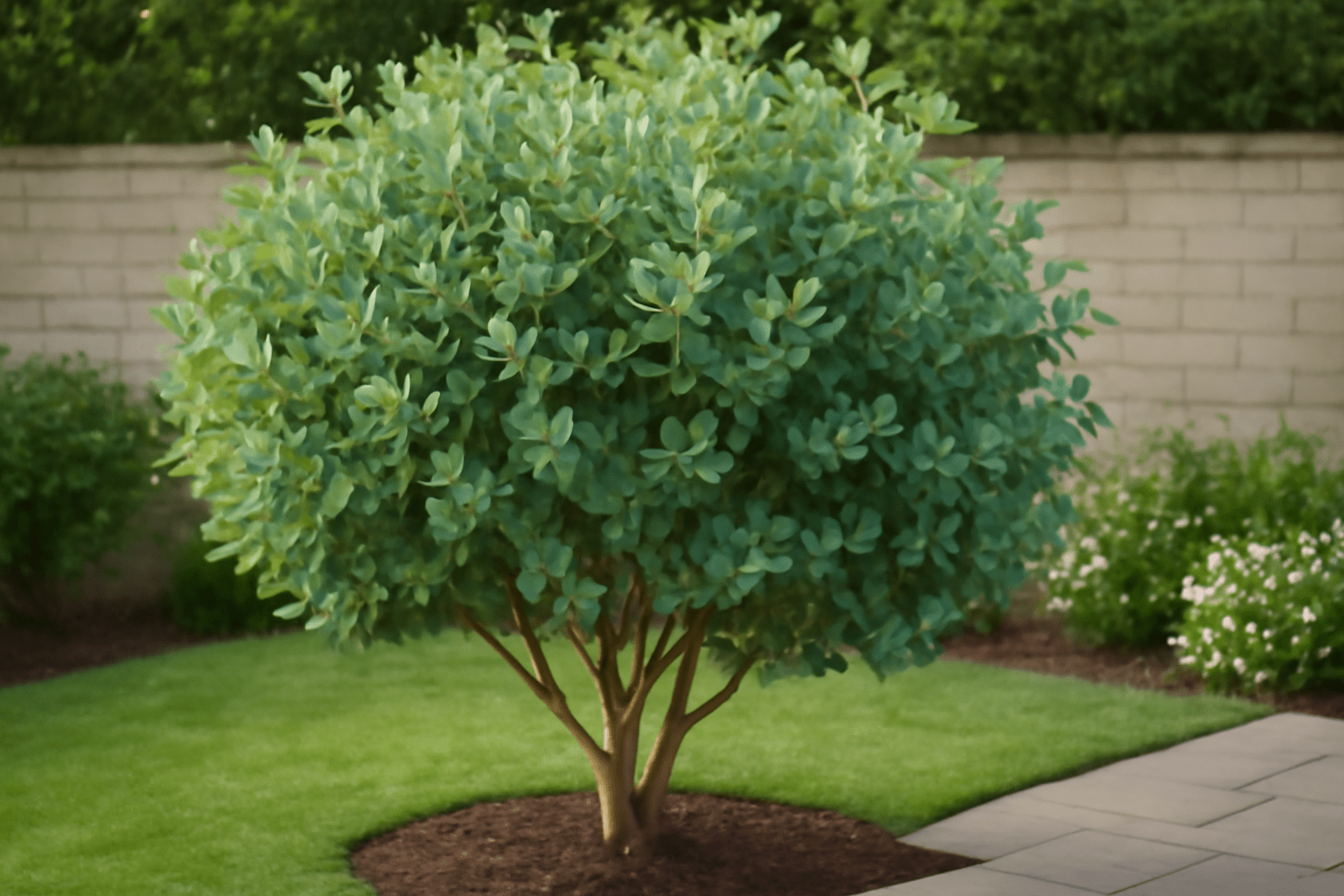
 Conclusion
Conclusion
Caring for a small eucalyptus tree is a rewarding journey that brings natural beauty, fresh fragrance, and a touch of greenery to your space 

Frequently Asked Questions (FAQs)
What is the best small eucalyptus tree variety for home gardens?
For home gardens, varieties like Eucalyptus gunnii (Cider Gum) and Eucalyptus pauciflora (Snow Gum) are popular. They stay compact, tolerate cooler climates, and have attractive foliage, making them ideal for small spaces.
How often should I water my small eucalyptus tree?
Young trees need deep watering once or twice a week, depending on climate and soil. Mature eucalyptus trees are drought-tolerant and usually only need watering during long dry spells.
Can small eucalyptus trees grow well in containers?
Yes! Small eucalyptus varieties adapt well to pots. Choose a large container with good drainage and repot every 2–3 years to avoid root crowding.
How do I prune my eucalyptus tree without harming it?
Prune in late winter or early spring by removing dead or weak branches. Lightly trim branch tips to encourage bushier growth. Eucalyptus trees tolerate pruning well, so don’t hesitate to shape them.
What type of soil is best for small eucalyptus trees?
Eucalyptus prefers well-draining soil with a slightly acidic to neutral pH (6.0–7.0). Avoid heavy clay soils that retain water, as they can cause root rot.
How much sunlight does a small eucalyptus tree need?
Full sun is best—your tree should get at least 6 hours of direct sunlight daily for healthy growth and vibrant leaves.
Are eucalyptus trees safe to plant near pets and children?
Eucalyptus leaves contain oils that can be toxic if ingested in large amounts. Keep trees out of reach of pets and children, and avoid letting them chew on leaves.
How can I protect my eucalyptus tree from pests and diseases?
Monitor regularly for common pests like aphids and psyllids. Use insecticidal soap or neem oil as needed, and ensure good air circulation around the tree to reduce disease risk.





